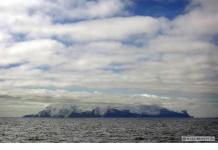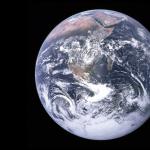That’s why Google covered it with a screen, and in the old version (more transparent) it was clear that there was no ice in the center. The Moon, which I saw around May 18, was in a hurry to the South. And among all the fables there is one that claims that at the South Pole there is an entrance to the center of the Earth, as well as a masking fable about a Nazi base.
In February, Argentina experienced its worst drought in 50 years. The drought killed 300 thousand heads of cattle. Farmer losses amounted to at least $600 million in the province of Santa Fe alone (this province lies between 28° and 34°).
At the end of February, severe fires began in southern Australia (30°-40°). It burned throughout March, but we managed to cope with the disaster, although there were isolated outbreaks back in April.
Meanwhile: fires in Mexico in March; fires in the southern USA since the beginning of April (in the south of California - since the beginning of May); the worst drought in 80 years in Brazil in April; severe drought in India since mid-April (hundreds of people die from the heat).
What about our Antarctica?
In January 2009, a high-ranking Russian delegation visited Antarctica (did they accept new suns?). The TV footage showed a very bright, high-standing Sun.
From the forum:
Others build all sorts of conspiracy theories, refer to trips of the establishment and political elite to Antarctica... (Hee hee).
The dynamics of the progress of the heat since February are in good agreement with the act of acceptance at the end of January - the thermal suns came out to the places of deployment (by the way, in 2010 no such cataclysms occurred: all the suns have long been in their places).
Meanwhile, in Antarctica, the ice bridge connecting the Wilkins Ice Shelf (opposite South America) to the mainland broke in early April, and began to collapse in late April. At the same time, in May, information was announced that there were no signs of warming in Antarctica (the luminaries had left and the weather had returned to normal).
A new winter is approaching. In Transbaikalia, in the first week of September, 20 cm of snow fell and record cold came. What about the suns?
And they go to a base in Antarctica (for maintenance and recharging?). This combination of temperature maps has already come across several times:
On August 14, a thermal spot suddenly appears in Antarctica (above the scale maximum of 10°), and on the 15th, a new thermal sun flares up in the middle of South America, which disappears after a couple of days, leaving only a stationary sun in the north of South America. This corresponds to leaving after recharging, but there are also reverse pictures (with arrival), unfortunately, not so clear, since maps of Antarctica are often either not updated at all, or are given with large white gaps. It is difficult to collect statistics to trace the correlation (maps are not saved, and there is no way to sit and monitor around the clock).
And finally, the question arises: “How are the suns recharged?”
From the forum:
A civil aviation pilot I know said that at altitudes above 9,000 km there is increased X-ray radiation. If earlier, when they flew to the USA and back to Russia via the North Pole in violation of all civil transportation standards and received 5 BER doses in one flight, now the same picture is in the lower latitudes. This suggests that the “fire” of space has approached the surface of the Earth. Many types of ailments: rapid fatigue, sudden rise and fall in temperature, wandering pains in the skeleton, hepatic discharge to the surface of the skin, headaches and unexpected increase in blood pressure, etc. and so on.
Key word spoken: radiation!
The suns run on the same nuclear fuel that was exported from Russia (by the way, Ukraine transfers its uranium reserve to us for storage). That's why chemtrails are needed: they really protect the earth from radiation! Hiding the luminaries and hiding cosmic information is just a by-product. That’s why birds don’t fly to the South (usually they are seen flying in cloudy weather), and after the radioactive fog they die out en masse (like bees, frogs, and plankton). That’s why I feel so bad after walking down the street, and for some reason I don’t want to take a shower. That is why the Penza prisoners hid underground, hoping to escape.
08.10.2009:
As Rospotrebnadzor explained to MK, complaints about poisoning by pine nuts have recently become more frequent. Moreover, in various parts of the country - from Moscow to Tyumen. In this case, all victims exhibit the same symptoms: a pronounced and persistent bitterness in the mouth that does not stop for several days, as well as general weakness and mild nausea.
But throughout the second half of summer the suns stuck out in Siberia!
There is another aspect that can be tied to the suns.
Interesting Google image (border between Norway and Sweden):
It’s clear what the white circle in the center of Antarctica hides.
But what could this square be hiding?
Here is a lower resolution image (from another program):

What are these red spots?
Similar ones were found in other places, also closed.
But in remote Siberia they were too lazy to close:


Therefore, desert areas are chosen. That's why it was so hot in the summer in Siberia.
In development of the version: satellite images.
Fires in northern Australia (the Indonesian sun only hits the north);
smoke from fires is visible.

But the fires in Siberia - smoke from the fires is not visible in the upper part of the image, but in the lower part it is not very clear whether it is smoke or clouds.
Maybe it's not fires?
And in Australia there is no smoke from single spots.
Pink snow fell in the Stavropol Territory, yellow snow fell in Crimea. The next day they said: it’s okay, it’s just that sand was brought in from Africa, this already happened in 2008 and 2009.
P.S. When the material had already appeared on the Internet, my old friend told me about two funny incidents from her life. She twice met pilots who carried out regular flights to Antarctica. Distinguished by extreme curiosity, she, almost already in bed, began to pester them with questions. There was only one scenario: with their tails fluffed up, they talked about the flight, about the countries under their wing, but as soon as the story reached the details of their arrival in Antarctica, their eyes glazed over, they apologized for being forced to leave urgently, got dressed and disappeared forever.
On January 28, 1820, a Russian expedition led by Thaddeus Bellingshausen and Mikhail Lazarev discovered Antarctica, the existence of which had previously only been speculated. Today we have collected for you interesting and little-known facts about the most remote southern continent - the highest, driest, windiest, sparsely populated and coldest place on earth.

At one time, it was impossible to work in Antarctica for those who had not had their wisdom teeth and appendix removed. Due to the fact that surgical operations were not performed at Antarctic stations, to work here it was necessary to first part with these parts of the body, even if they were completely healthy.

Antarctica is the driest place on earth. More precisely, the dry McMurdo Valleys located here, some areas of which have not seen rain or snow for two million years.

Like many countries, Antarctica has its own Internet domain - .aq

53 million years ago, Antarctica was so warm that palm trees grew on its shores and the air temperature rose above 20 degrees Celsius.

In December 2013, Metallica gave a concert in Antarctica, thus becoming the first band in the world to perform on all continents. In order not to disturb the local fauna, the concert was held under a special protective dome, and the audience listened to the music through headphones.

From 1960 to 1972, McMurdo Station, the largest settlement and research center owned by the United States, operated the first nuclear power plant in Antarctica.

Antarctica has its own fire station. It belongs to the McMurdo station, and it employs real professional firefighters.

Despite the extreme conditions, 1,150 species of fungi have been discovered in Antarctica. They adapt well to extremely low temperatures and extended periods of freezing and thawing.

Technically, all 24 time zones are present in Antarctica, since their boundaries converge at one point at both poles.

There are no polar bears in Antarctica. To look at them, you will have to go to the North Pole or, for example, to Canada.

There is a bar in Antarctica - the southernmost bar on the planet. And it is located at the Akademik Vernadsky station, which belongs to Ukraine.

The lowest temperature ever recorded on earth - minus 89.2 degrees Celsius - was recorded in Antarctica at the Russian Vostok station on July 21, 1983.

Antarctica is the fifth largest continent in the world. Its territory is 14 million square meters. km.

99% of Antarctica is covered in ice. The continent's ice sheet is often called an ice sheet.

The average ice thickness of Antarctica is 1.6 km. Antarctica contains approximately 70% of all fresh water on earth.

The Transantarctic Mountains run across the entire continent and divide it into western and eastern parts. This ridge is one of the longest in the world - its length is 3500 km.

The existence of the continent of Antarctica was unknown until its discovery in 1820. Before this it was assumed that it was just a group of islands.

On December 14, 1911, Norwegian explorer Roald Amundsen became the first person to reach the South Pole and plant his nation's flag there. He also became the first person to visit both geographic poles of the planet.

As a result of secret negotiations, on December 1, 1959, 12 countries concluded the Antarctic Treaty, providing for the demilitarization of the Antarctic region and its use for exclusively peaceful purposes. Today, more than 50 countries are parties to the Treaty.

On January 7, 1978, Argentinean Emilio Marcos Palma was born - the first person in history to be born in Antarctica. It is believed that this event was a planned action by the Argentine government, which specifically sent a pregnant woman to the Esperanza station in order to subsequently claim rights to part of the territory of Antarctica.
5.5.2. Food for thought. View of the Earth's poles from space
This section will provide information that may be perceived ambiguously, but, nevertheless, it is so interesting in itself that it would be wrong not to indicate it. Below I will touch upon the issue of observations from space of the North and South poles of the Earth. They also show a number of interesting analogies, and I would like to do some comparison of the data.
The most objective study of the polar zones would be a targeted and systematic study of the field structure of the Earth and other planets from space. Repeatedly duplicated photography is required in different radiations, from different points, at different positions in the orbits of not only the Earth, but also other planets (to take into account their influence). It is necessary to systematize photographic documents and make them accessible to a wide range of researchers in various specialties. Even if this is done, there are no systematic publications. Those materials that appear in the press, on the websites of NASA and some others, are scattered, sometimes edited and retouched, and sometimes completely fake. Commentary on them, from a scientific point of view, is often unsatisfactory or non-existent.
Let's analyze from the perspective of the proposed hypothesis several images of our planet obtained from space. Mostly, information leaks into publications that are not very respected in scientific officialdom, but still, still... If you put everything together and try to compare it, you get very interesting generalizations. Excerpts with photographs from such publications (and comments on them) are presented below. But they are all popular in nature and look like possible overblown journalistic sensations. Science, on the other hand, has taken water into its mouth and remains silent (at least as regards the poles of the Earth and the Moon).
4 , 5 , 6 - stills from the video https://www.youtube.com/watch?v=1KlezOMGBV0
In the Foto 1 a little north of Greenland we see a “black hole” or a black “patch”. The image very clearly captures the outlines of the continents, inland seas, Greenland, the Scandinavian Peninsula, and a chain of islands. In the Foto 2 The same area is shown, also from a satellite. The difference is obvious, however, the Arctic Ocean is covered with ice. Here, as they say, comments are unnecessary. Finally, in the photo 3 we see just a huge and very impressive hole.
Regarding the last photo in http://mrpumlin.livejournal.com/69636.html the following is written:
In 1968, the American meteorological satellite Essa-7 transmitted strange images of the North Pole to Earth. In the complete absence of clouds, which is extremely rare in such photographs, a huge hole is visible in the area of the pole - an opening. The photo is genuine - examinations were carried out several times. Without denying the authenticity, a counterargument is given that, they say, this is the result of the tilt of the planet in relation to the sun's rays, this is not a hole, but a play of light and shadow. Some pictures supposedly have a hole, while others don't.
In the bottom row there are also photographs of the North Pole, but from the video (the link is indicated under the picture) - 4 -Me and 5 -The photos are exactly the same, but one does not have a “patch”, while the other does. On the right, the Earth is rotated differently, and the “causal place” is again covered.
The reliability of all the photographs presented can be questioned. Moreover, they do not specify either the conditions or the shooting dates. But... still there is no smoke without fire.
It turns out that there are photographs of the North Pole with reliable links directly to NASA, confirming the presence of, if not a hole, then some kind of strange funnel. And since it still seems inexplicable to science, it is practically not discussed. The picture was taken by the American ESSA-7 spacecraft. Photo from science.Ksc.nasa.gov (Fig. 5.37).

Rice. 5.37. Photograph of the North Pole at different magnifications,
I managed to find another completely independent evidence of the existence of something very strange, very similar to the presence of a hole or funnel, and precisely at the North Pole. The most important thing is that the publication has nothing to do with discussing the hollow Earth, the presence or absence of a hole, etc.
In 2007, NASA launched a mission called Mesosphere Ice Aeronomy, or Target for short, to study noctilucent clouds. Noctilucent clouds occur 50 miles (80 km) above the Earth's surface and can reflect light from the Sun. These were the ones “Target” photographed (Fig. 5.38).

Rice. 5.38. Noctilucent clouds over the North Pole,
In addition, from the images obtained by this mission, a video was compiled even indicating the dates of daily shooting in the period from May 20 to September 2, 2007. Several frames from the video are shown in Fig. 5.39.

Rice. 5.39. Stills from the video with noctilucent clouds,
The most important oddity of this study was left out of discussion. True, it was dealt with by specialists in atmospheric physics and meteorologists, But still... Or again, excuse me, “noodles on the ears”, but a “patch” on the pole?
Now let's look at the South Pole from the same positions.
South Pole
The situation is similar with the filming of the South Pole: in some photographs there is a “hole”, but in most there is none. In Fig. 5.40 ( 1 ) a photograph with a “hole” is shown. The shooting conditions are not specified. Right – photograph 2 – without a “hole”, but with aurora (photographed by NASA).

Rice. 5.40. Antarctica near the South Pole,
Photo 2 and its peculiar interpretation is given in the article by Mark Sokolov “Hole in Antarctica. Do the aurora come from the Earth? (UFO newspaper, October 2006). The issue is considered from the perspective of Hollow Earth supporters. The comments are mainly about the nature of the auroras (the so-called “southern aurora”). M. Sokolov writes:
The authors of the Radarsat website, offering their analysis of these sensational NASA materials, ask to take into account that this is by no means the type of hole that, being on a flat horizontal plane, ends abruptly downward. No, in fact, almost the entire area of Antarctica surrounding the hole is a gradually descending terrain, as if going down, similar to what we can see in an hourglass. For us, the problem is that we cannot feel the volume of this landscape - after all, we have a flat picture taken from above. And therefore the hole looks as if it was drilled on a flat surface. In reality, however, this is not entirely true. Or rather, not at all like that... The photographs were provided by Jones McNibbley, one of the most active proponents of the idea of a hollow Earth. As he himself explains, the filming of Antarctica was made by the IMAGE satellite, whose task is to “supply” video materials about the planet’s magnetosphere. And on his Internet block, McNibbley provides two fragments of these videos. If you look at them more closely, you will notice that fog is coming out of the hole - on the right side of the dark spot.Exactly fog and allows supporters of the hollow Earth hypothesis to consider our planet hollow and claim that it comes from an internal cavity as evidence of its ventilation (!!!).
Photo 2 I have added points 1 – 4, in order to roughly indicate the places mentioned in the article: 1 – South Geographic Pole, 2 – McMurdo Station (USA), 3 – Vostok Station (Russia), 4 – “hole” point (84, 4 degrees south latitude and 39 degrees east longitude), the coordinates of which are given by M. Sokolov. In the left photo, Australia is visible at the top left.
By the way, the position of the supposed holes in the left and right photographs does not coincide in coordinates.

Rice. 5.41. South Pole. Stills from the video,
Exactly the same story as with photographs of the North Pole: somewhere there is a “patch”, somewhere there is not (the South Pole is indicated by a yellow button). In the left photo we see a clearly defined area against the background of ice. It is also visible in the right frame. This is what in the language of geophysicists is called a depression (lowering of the terrain), and in this case it is very similar to a funnel. And in the two photographs in the middle, even the “patch” is not quite well placed: the bright spot of the funnel is not completely covered.
Well, the most powerful chord that concludes this topic is the video, three frames from which I have shown in Fig. 5.42. This is simply phenomenal, but it is also not discussed anywhere in the scientific world, at least not in the open press.

Rice. 5.42. Shooting of the South Pole from the Mir orbital station (1987),
Well, where can you go? And “patches and blotches” cannot be adapted. Filmed by astronauts from the Mir orbital station, launched in 1986. In the said video, the hole is called a Portal, but that doesn’t matter to us. The fact itself is important. True, I must admit that at first I began to doubt the reliability. Our orbital stations with people in polar orbits do not fly. The limit, then and now, is somewhere around 50º latitude in both the north and south. But then I thought that the orbital altitude was 400 km. Therefore, it is quite possible. Voyager filmed the planet Jupiter almost from the equatorial plane, but the poles, although not very successfully, can be seen quite clearly with some computer processing (this will be discussed in detail in the chapter on Jupiter).
In some publications regarding the study of the Earth's polar zones using spacecraft, the assertion that probes lose their orbits and crash over the poles is used as a fig leaf to cover secrecy. And so, after several unsuccessful attempts, the orbits of the satellites were shifted so that they did not pass over the pole itself - what you see in Fig. 5.43.

Rice. 5.43. Polar orbits of satellites, http://zhitanska.com/sites/default/files/images/stories/ZHVV/Polaya_Zemlya/orbiti_sputnikov.jpg
Are satellites getting lost over the poles? Quite possible. Just remember the information about what happened to the planes flying over the pyramids of Giza during the Israeli-Egyptian war in the 50s of the last century. American planes fought on the Israeli side, and ours on the Egyptian side. Both noted that as soon as the plane was above the pyramids, the instruments failed, orientation was lost, and the planes were poorly controlled. By some miracle they managed to avoid collisions in the air. Since then, aircraft flights over the pyramids have been prohibited in Egypt. There is similar evidence of aircraft flying over the pyramids of China.
But these are only pyramids with their energy pillars above the tops. And at the poles there are Hyperboloid funnels with incredible power of cosmic and terrestrial energy vortices!
SUMMARY
I will not make any generalizations or repeat certain points. You've already read it all. The main thing in this chapter, as in the entire book, is the idea of the Field Hyperboloid. I was struck by the very simplicity of the subtle structure of the Hyperboloid, the governing and communicative organ of the Entity called PLANET EARTH. And the thought immediately sunk in that such a phenomenon could not be something exceptional, purely individual, characteristic only of our planet. Still, the Principles of Hermeticism and fractality in the Universe long before entered the depths of my worldview.
And then information from automatic space probes began to appear. The first photographs of Jupiter's North Pole taken by Voyager and animations showing its "strangeness" were for me a direct confirmation of the correctness of the idea of the Field Hyperboloid as the heart for another celestial body. Then information came from Cassini about Saturn... etc. Further more. Confirmations of my thoughts poured in from American probes like from a cornucopia. And I realized that the Field Hyperboloid is a Universal Principle. Why doesn't anyone see this except me? The implementation of the Field Hyperboloid Principle on the scale of the Solar System became clear to me, but I wanted to convey this idea to people. Thus the idea was born - to write a book using actual experimental data to explain what science is still at a dead end.
Doesn’t it seem very strange to you, dear friends, that we are given much more information about the poles of Jupiter, Saturn, even Uranus and Neptune than about our own?
And another important point: recently, great attention has been paid to the study of the poles. The governments of all countries suddenly began to fuss and, as they say, “dig the earth with their horns.” It's not just about the richness of fossils on the shelf of the Arctic Ocean or Antarctica. Oh, not only... Information about the Earth is extremely closed, but information is already coming from Juno, which reached Jupiter in July of this year and revolves around it only in polar orbits. Why did the poles suddenly become so important and interesting to Americans?
Science is interested in the poles!!! What would this mean???
The next chapter, using the solar system as an example, will examine scientific data obtained from space probes and telescopes confirming that magnetic manifestations in the polar regions of the planets are very similar to what we talked about regarding the Earth. This suggests that The process of Creation occurs according to a single scenario. And, most importantly, this is not just a pattern template, this is a UNIVERSAL PRINCIPLE OF THE UNIVERSE.

Using images from space, scientists have compiled a detailed map of the sixth continent. And they discovered unusual objects on it
Last week, experts from the National American Space Agency and the British Antarctic Society announced the creation of the most detailed three-dimensional map of the icy continent. For three years, from 1999 to 2001, the Landsat-7 space satellite captured 1,100 images of Antarctica from all possible angles. Plus several tens of thousands of aerial photography frames. Scientists spent another six years studying the images and putting this mosaic together. True, a complete map of the continent still did not work out. Due to the peculiarities of the orbits of the Earth's satellites, it was not possible to photograph the very “top” of our planet - the region of the South Pole. But this does not bother scientists: although the first space photographs of this continent appeared back in 1972, and the first map in 1998, the current one turned out to be 10 times clearer than all previously existing images of the white continent. For example, you can see objects measuring 15x15 meters. That is, half a basketball court. In addition, all photographs are given in real color, and you can use the map to
to see what Antarctica really looks like from space.
According to project leader Robert Bienshadler of NASA's Hydrosphere and Biosphere Laboratory, if scientists around the world "used to study the ice continent on a black-and-white TV, now they were provided with the most sophisticated color TV."
The map will also help to assess how, and indeed whether, global warming is affecting Antarctica. Now the situation is ambiguous. Satellite images show that, on the one hand, in the Ross Sea area, coastal glaciers are rapidly melting and sliding into the sea, but in other areas the area of ice fields is increasing.
There are no more “white” spots left on the white continent. However, while experts were working on drawing up the map, they saw a lot of unexpected things. And they racked their brains to explain what they saw.
Anomalous airfield
“This simply cannot happen!” Legend has it that this is exactly what one graduate student exclaimed when he was assigned to analyze images sent from orbit by the Landsat-7 probe. Someone is giving a sign of distress and has laid out a giant cross in Antarctica.
Everything turned out to be much simpler. "X" - two runways of the American polar station McMurdo.
By the way, to the left of the point of their intersection you can see the dome of the station.
Noah frozen in the ice?
And this photo was liked by lovers of everything anomalous. The picture is unusually similar to the remains of Noah’s Ark, which is said to have been petrified on the slope of Ararat (see photo below). In fact, this region of the Dry Valleys is the only place in Antarctica that is free of snow.
|
How icy rivers flow
Similar photographs can often be seen among archaeologists.
Using aerial photography, they determine the contours of ancient cities covered with sand or earth.
And scientists discovered something similar in Antarctica. Alas, these are not ruins left by a mysterious civilization. And the “river” is an ice stream that moves at a speed of several hundred meters per year. And if there are any obstacles at the bottom of the river or two rivers collide, then whirlpools begin, as in this photo.
BY THE WAY
Currently, there are 50 polar research stations from 20 countries operating in Antarctica. Russia contains 6 permanent stations and two seasonal ones. This year, plans are underway for the next, 53rd Russian Antarctic Expedition, to re-open two more of our stations, closed in the late 80s of the last century.





















